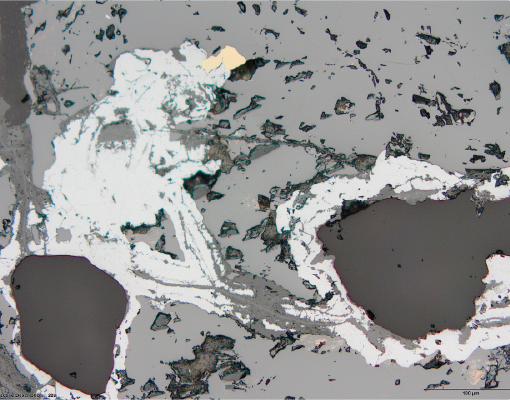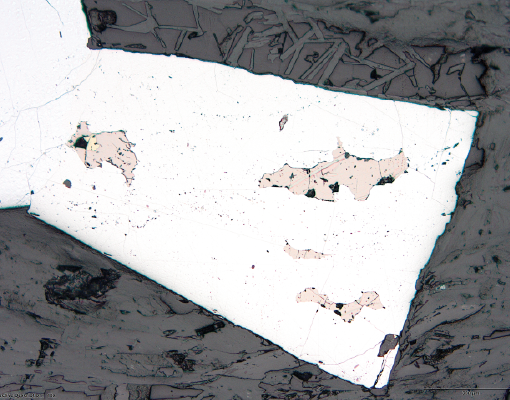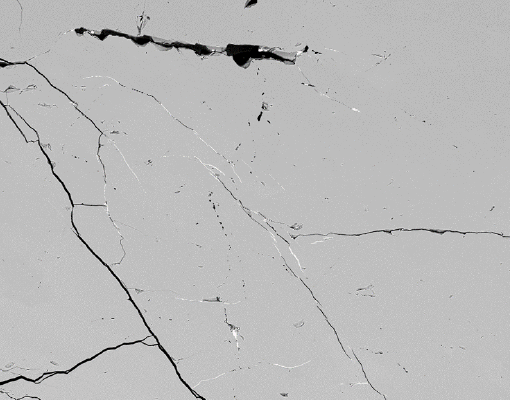
Eric Nowariak
Exploration Geologist
Petrography: A Critical Eye On Gold Mineralization
Gold (Au) occurs in rocks in a multitude of textures, sizes, and concentrations and with a variety of mineral associations. Understanding where and how gold occurs within mineralized areas is an important and often overlooked aspect in exploring for and ultimately mining Au-rich ore deposits.
By employing in-house petrographic analysis of mineralized samples, we can identify textural, mineralogical, and paragenetic controls on gold mineralization. Simply observing minerals that host gold and other associated ore minerals can provide important information as to the paragenesis (relative timing) and geochemical signature of gold mineralization. Such mineral associations can identify first-order controls on mineralization that can drive early-stage exploration.
GOLD: Understanding Visual Properties
Gold is easily distinguished in polished section based on its high reflectance, bright yellow color, and scratches indicative of its low polishing hardness. Explorationists can add value early in the process through visually identifying direct controls on gold mineralization. Early petrographic analysis helps filter through the noise of initial datasets before programs undertake more advanced stage geometallurgical studies.
COLOR
Bright Yellow
REFLECTANCE
Very High
BIREFLECTANCE
None
ANISOTROPY
Isotropic
CLEAVAGE
None
HARDNESS
Low
UndeR The Scope: The Devil Is In The Details
Gold occurs in ore deposits principally as grains of the native element (its pure form) often alloyed with native silver to form electrum. Native gold refers to grains with >80% Au, while electrum refers to grains with 50-80% Au. Under reflected light, a trained eye may be able to identify small differences in reflectance and color to distinguish relative abundances of gold and silver in electrum grains. However, for quantitative compositions of electrum grains, more sophisticated analyses like SEM or EMPA are required.
In other cases, especially in large-tonnage Carlin type deposits, gold can occur as invisible gold, wherein small amounts of the element are incorporated into the crystal structure of sulfide minerals such as As-Sb-rich pyrite or galena through coupled substitution. This type of mineralization is more difficult to identify in polished section, but optical zonation and anomalous optical properties are often indicative of Au-Ag-bearing sulfides. Gold can also occur as a primary component of bismuth and telluride minerals like calaverite (AuTe2), sylvanite ((Ag, Au)Te2), and maldonite (Au2Bi).

A | ~15 micron, rough grain of Au with Boulangerite in quartz-carbonate vein. Reflected Light, PPL, 20x

B | ~15 micron, rough grain of Au with Pyrrhotite within Arsenopyrite grain

C | Au along Pyrrhotite and Arsenopyrite grain margins

D | Backscatter Electron Image of sub-micron microfracture controlled gold (bright) in Arsenopyrite grain (grey)
Simply observing minerals that host gold and other associated ore minerals can provide important information as to the paragenesis (relative timing) and geochemical signature of gold mineralization. Such mineral associations can identify first-order controls on mineralization that can drive early-stage exploration.
One of the most important aspects of exploration and metallurgy of gold-rich deposits is the texture of the gold grains. Gold and electrum grains range in morphology, size and host mineral. Although gold and electrum grains do not have a consistent cleavage or crystal structure, the morphology of each grain is often inherited from the host minerals or host fractures. For instance, free-milling gold occurs in coarse, roughly shaped grains along mineral grain margins and in fractures. Conversely, ores that contain invisible gold and fine grains of native gold that are completely enveloped by individual minerals are referred to refractory gold which may require more sophisticated processing.
Not only can ore microscopy help delineate ore genesis through geochemical and mineralogical associations, it can render valuable information on the processing of the ores.
On The Value Of Petrography
“Simply observing minerals that host gold and other associated ore minerals can provide important information as to the paragenesis (relative timing) and geochemical signature of gold mineralization. Such mineral associations can identify first-order controls on mineralization that can drive early-stage exploration.”
Eric Nowariak, Exploration Geologist

